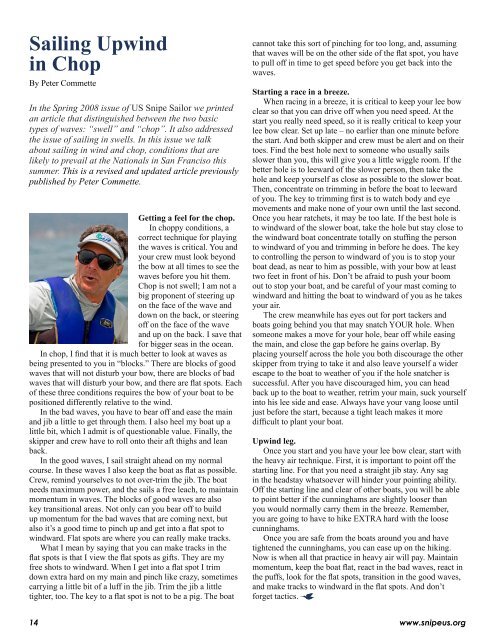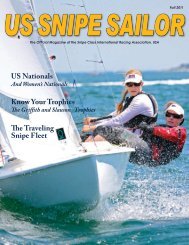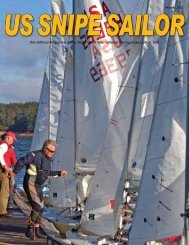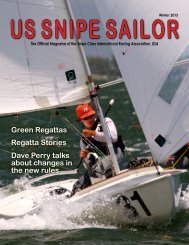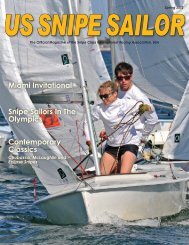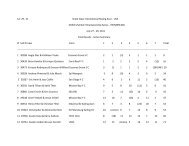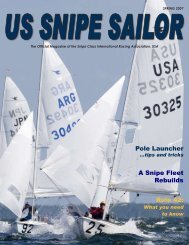Summer 2008 - United States Snipe Sailing
Summer 2008 - United States Snipe Sailing
Summer 2008 - United States Snipe Sailing
You also want an ePaper? Increase the reach of your titles
YUMPU automatically turns print PDFs into web optimized ePapers that Google loves.
<strong>Sailing</strong> Upwind<br />
in Chop<br />
By Peter Commette<br />
In the Spring <strong>2008</strong> issue of US <strong>Snipe</strong> Sailor we printed<br />
an article that distinguished between the two basic<br />
types of waves: “swell” and “chop”. It also addressed<br />
the issue of sailing in swells. In this issue we talk<br />
about sailing in wind and chop, conditions that are<br />
likely to prevail at the Nationals in San Franciso this<br />
summer. This is a revised and updated article previously<br />
published by Peter Commette.<br />
Getting a feel for the chop.<br />
In choppy conditions, a<br />
correct technique for playing<br />
the waves is critical. You and<br />
your crew must look beyond<br />
the bow at all times to see the<br />
waves before you hit them.<br />
Chop is not swell; I am not a<br />
big proponent of steering up<br />
on the face of the wave and<br />
down on the back, or steering<br />
off on the face of the wave<br />
and up on the back. I save that<br />
for bigger seas in the ocean.<br />
In chop, I find that it is much better to look at waves as<br />
being presented to you in “blocks.” There are blocks of good<br />
waves that will not disturb your bow, there are blocks of bad<br />
waves that will disturb your bow, and there are flat spots. Each<br />
of these three conditions requires the bow of your boat to be<br />
positioned differently relative to the wind.<br />
In the bad waves, you have to bear off and ease the main<br />
and jib a little to get through them. I also heel my boat up a<br />
little bit, which I admit is of questionable value. Finally, the<br />
skipper and crew have to roll onto their aft thighs and lean<br />
back.<br />
In the good waves, I sail straight ahead on my normal<br />
course. In these waves I also keep the boat as flat as possible.<br />
Crew, remind yourselves to not over-trim the jib. The boat<br />
needs maximum power, and the sails a free leach, to maintain<br />
momentum in waves. The blocks of good waves are also<br />
key transitional areas. Not only can you bear off to build<br />
up momentum for the bad waves that are coming next, but<br />
also it’s a good time to pinch up and get into a flat spot to<br />
windward. Flat spots are where you can really make tracks.<br />
What I mean by saying that you can make tracks in the<br />
flat spots is that I view the flat spots as gifts. They are my<br />
free shots to windward. When I get into a flat spot I trim<br />
down extra hard on my main and pinch like crazy, sometimes<br />
carrying a little bit of a luff in the jib. Trim the jib a little<br />
tighter, too. The key to a flat spot is not to be a pig. The boat<br />
cannot take this sort of pinching for too long, and, assuming<br />
that waves will be on the other side of the flat spot, you have<br />
to pull off in time to get speed before you get back into the<br />
waves.<br />
Starting a race in a breeze.<br />
When racing in a breeze, it is critical to keep your lee bow<br />
clear so that you can drive off when you need speed. At the<br />
start you really need speed, so it is really critical to keep your<br />
lee bow clear. Set up late – no earlier than one minute before<br />
the start. And both skipper and crew must be alert and on their<br />
toes. Find the best hole next to someone who usually sails<br />
slower than you, this will give you a little wiggle room. If the<br />
better hole is to leeward of the slower person, then take the<br />
hole and keep yourself as close as possible to the slower boat.<br />
Then, concentrate on trimming in before the boat to leeward<br />
of you. The key to trimming first is to watch body and eye<br />
movements and make none of your own until the last second.<br />
Once you hear ratchets, it may be too late. If the best hole is<br />
to windward of the slower boat, take the hole but stay close to<br />
the windward boat concentrate totally on stuffing the person<br />
to windward of you and trimming in before he does. The key<br />
to controlling the person to windward of you is to stop your<br />
boat dead, as near to him as possible, with your bow at least<br />
two feet in front of his. Don’t be afraid to push your boom<br />
out to stop your boat, and be careful of your mast coming to<br />
windward and hitting the boat to windward of you as he takes<br />
your air.<br />
The crew meanwhile has eyes out for port tackers and<br />
boats going behind you that may snatch YOUR hole. When<br />
someone makes a move for your hole, bear off while easing<br />
the main, and close the gap before he gains overlap. By<br />
placing yourself across the hole you both discourage the other<br />
skipper from trying to take it and also leave yourself a wider<br />
escape to the boat to weather of you if the hole snatcher is<br />
successful. After you have discouraged him, you can head<br />
back up to the boat to weather, retrim your main, suck yourself<br />
into his lee side and ease. Always have your vang loose until<br />
just before the start, because a tight leach makes it more<br />
difficult to plant your boat.<br />
Upwind leg.<br />
Once you start and you have your lee bow clear, start with<br />
the heavy air technique. First, it is important to point off the<br />
starting line. For that you need a straight jib stay. Any sag<br />
in the headstay whatsoever will hinder your pointing ability.<br />
Off the starting line and clear of other boats, you will be able<br />
to point better if the cunninghams are slightly looser than<br />
you would normally carry them in the breeze. Remember,<br />
you are going to have to hike EXTRA hard with the loose<br />
cunninghams.<br />
Once you are safe from the boats around you and have<br />
tightened the cunninghams, you can ease up on the hiking.<br />
Now is when all that practice in heavy air will pay. Maintain<br />
momentum, keep the boat flat, react in the bad waves, react in<br />
the puffs, look for the flat spots, transition in the good waves,<br />
and make tracks to windward in the flat spots. And don’t<br />
forget tactics.<br />
1 www.snipeus.org


